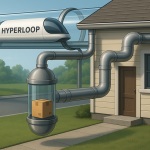In 2022, I first wrote about this topic on my blog (link), and later presented it as a paper titled “Cargo Delivery Evolution with Hyperloop” at the International Trade and Logistics Congress organized by Kayseri University on December 19–20, 2024, under the theme Innovative Practices in the Logistics Sector. I now aim to convey this topic with more visual elements.
The package and document delivery (cargo) industry is undergoing continuous transformation, and within the next thirty years, it will evolve into something that currently seems like science fiction but is far from being utopian. In a global world where technology advances daily, every sector is rapidly adopting innovative models — and the logistics industry is no exception. Since teleportation hasn’t yet been invented, the logistics sector is increasingly focused on minimizing the time between sender and receiver. Artificial intelligence models and technological advancements aim to reduce this duration to an absolute minimum.
Hyperloop is a service that has been in development for a long time and is already being applied in the transportation sector. Its main goal is to shorten travel time between cities and improve time efficiency. In the near future, this model will also be implemented in the cargo industry. Here’s how it will work:
Homes will have dedicated Hyperloop-like delivery lines — essentially replacing traditional mailboxes. Packages and documents of certain dimensions will travel from their origin to destination via these high-speed lines, reaching recipients more securely and rapidly. These lines will be a required infrastructure in new buildings and will include in-building cargo delivery stations.
For example, when you purchase a product from an e-commerce platform, once it is prepared, it will be dispatched through these lines directly to the recipient. The line, like a metro system, will follow a designated route and deliver the item to its destination. Throughout this process, the entire journey will be trackable online and monitored via web-based systems, with notifications sent to both sender and receiver.
This can be likened to the pneumatic tube systems currently used in hospitals. Logistics is one of the sectors most adaptable to future technologies, as it plays a vital role in meeting human needs in the fastest, safest, and most cost-effective way possible. The Hyperloop model is crucial not only for speed but also for reducing carbon emissions and promoting environmental sensitivity.

The future of logistics is now part of your life.”
Packages emerging from futuristic storage systems join the near-light-speed journey of Hyperloop.
And now… we descend beneath the city.”
“With advanced pneumatic networks reaching into your home, your delivery arrives in minutes.
Silent. Contactless. Impressive.”
“The future is now just one capsule away.”
System Architecture
1. Warehouse and Capsule Preparation
Fully automated warehouse systems select and place ordered products with high precision into compact magnetic capsules, optimized for Hyperloop transport.

2. Hyperloop Transport
Hyperloop capsules travel at speeds of up to 1000 km/h toward city centers, offering a nearly vibration-free and silent experience. The capsules are made of transparent materials, ensuring visibility and transparency throughout the process.
3. Pneumatic Tube Network System
Upon arrival at the city hub, the Hyperloop capsule integrates into a subterranean pneumatic distribution network. Each home is identified with a unique code and connection point within this network. The capsule is routed to the corresponding household and transferred using vacuum pressure.
4. Delivery Point
Each home is equipped with a small built-in delivery station that receives the capsule securely. Users can monitor the delivery process in real time via a mobile app.

Advantages
| Category | Benefit |
| Speed | Deliveries reach homes within 15–20 minutes |
| Security | Contactless, trackable, and locked system |
| Environment | Fossil fuel-free, low carbon footprint |
| Silence | No contribution to urban noise |
| Automation | Minimal need for human labor |
Challenges and Infrastructure Requirements
Implementing this system will require significant changes to urban infrastructure, including:
- Construction of extensive pneumatic tube networks
- Standardization of home delivery stations
- Integration of Hyperloop terminals closer to city centers
- Data infrastructure adapted for full automation
This technology has the potential to revolutionize not only individual deliveries but also emergency medical supplies, lab samples, and even food logistics. When integrated into smart city projects, the concept of “instant logistics” could become the new standard.
The integration of Hyperloop and pneumatic cargo systems is more than a delivery mechanism — it is a transformative ecosystem that redefines modern life. It establishes the foundation for a future logistics architecture where urban deliveries are nearly invisible, silent, and instantaneous.
I believe this model will become a part of our daily lives within the next 20–30 years.
Halit KAYA
📧 hltky550@gmail.com
🌐 www.halitkaya.net



Ne düşünüyorsun / sanıyorsun?